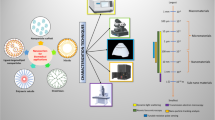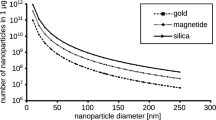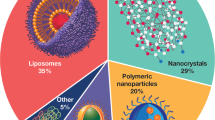Abstract
Purpose
Most relationships between size and nanomedicine performance and safety were established before the early 2010s’ when batch-mode dynamic light scattering (batch-mode DLS) was the only easy size measurement method for colloids available. They are basis for the rational design of nanomedicines, but misunderstood contrasting results are reported. This work aimed to investigate whether these relationships can be used with confidence knowing that batch-mode DLS can be tricky when measuring sizes of polydisperse systems.
Methods
A polydisperse dispersion of polymer nanoparticles ranging from 100 to 465 nm was synthesized. The particles were separated in 4 fractions by successive centrifugations. The capacity of each fraction and parent dispersion to activate the complement system was evaluated by Crossed immuno-electrophoresis.
Results
Each fraction was a population of particles with a distinct size. It showed a different capacity to activate the complement system. Particles of the fractions showing the strongest capacity to activate the complement systems had a different size evaluated by batch-mode DLS then that of the parent particles.
Conclusion
Particles activating the complement system in the parent dispersion were not those that were detected by batch-mode DLS while measuring its size. This work pointed out that previously established relationships between nanomedicine size and their biological response should be taken with caution if sizes were only measured by batch-mode DLS.









Similar content being viewed by others
Abbreviations
- DLS:
-
Dynamic light scattering
- C3A50:
-
Concentration in particles expressed in cm2.mL−1 required to activate 50% of the protein C3 of the complement system in the experimental conditions of the test.
- EDTA:
-
Ethylene diamine tetraacetic acid
- EGTA:
-
Ethylene glycol tetraacetic acid
- IBCA:
-
Isobutylcyanoacrylate
- ISO:
-
International Standard Organization
- PdI:
-
Polydispersity Index
- PIBCA:
-
Poly(isobutylcyanoacrylate)
- SDV:
-
Standard deviation
- SOP:
-
Standard operating conditions
- TEM:
-
Transmission electron microscopy
- TRPS:
-
Tunable resistive pulse sensing
- VBS2+ :
-
Veronal buffer supplemented with calcium (0.15 mM) and magnesium (0.5 mM)
- VBS5X:
-
Veronal buffer concentrated by 5 times.
- VBS-EDTA:
-
Veronal buffer supplemented with EDTA (40 mM)
- VBS-EGTA+Mg2+ :
-
Veronal buffer supplemented with EGTA (10 mM) and magnesium (2.5 mM)
References
Wicki A, Witzigmann D, Balasubramanian V, Huwyler J. Nanomedicine in cancer therapy: challenges, opportunities, and clinical applications. J Control Release. 2015;200:138–57.
Juliano R. The delivery of therapeutic oligonucleotides. Nucleic Acids Res. 2016;44:6518–48.
Mura S, Couvreur P. Combining imaging and drug delivery for the treatment of severe diseases. In: Mura S, Couvreur P, editors. Nanotheranostics for personalized medicine. Singapore: World Scientific Publishing Co. Pte. Ltd; 2016. p. 1–6.
Hare JI, Lammers T, Ashford MB, Puri S, Storm G, Barry ST. Challenges and strategies in anti-cancer nanomedicine development: an industry perspective. Adv Drug Deliv Rev. 2017;108:25–38.
Lacombe S, Porcel E, Scifoni E. Particle therapy and nanomedicine: state of art and research perspectives. Cancer Nanotechnol. 2017;8:9.
Luque-Michel E, Imbuluzqueta E, Sebastián V, Blanco-Prieto MJ. Clinical advances of nanocarrier-based cancer therapy and diagnostics. Expert Opin Drug Deliv. 2017;14:75–92.
Pelaz B, Alexiou C, Alvarez-Puebla R, et al. Diverse applications of Nanomedicine. ACS Nano. 2017;11:2313–81.
Ventola CL. Progress in Nanomedicine: approved and investigational Nanodrugs. P T. 2017;42:742–55.
Cicha I, Chauvierre C, Texier I, Cabella C, Metselaar JM, Szebeni J, et al. From design to the clinic: practical guidelines for translating cardiovascular nanomedicine. Cardiovasc Res. 2018;114:1714–27.
Dormont F, Varna M, Couvreur P. Nanoplumbers: biomaterials to fight cardiovascular diseases. Mater Today. 2018;22:122–43.
Dormont F, Rouquette M, Mahatsekake C, Gobeaux F, Peramo A, Brusini R, et al. Translation of nanomedicines from lab to industrial scale synthesis: the case of squalene-adenosine nanoparticles. J Control Release. 2019;307:302–14.
Rodríguez-Nogales C, González-Fernández Y, Aldaz A, Couvreur P, Blanco-Prieto MJ. Nanomedicines for pediatric cancers. ACS Nano. 2018;12:7482–96.
Valero L, Alhareth K, Gil S, Lecarpentier E, Tsatsaris V, Mignet N, et al. Nanomedicine as a potential approach to empower the new strategies for the treatment of preeclampsia. Drug Discov Today. 2018;23:1099–107.
Couvreur P. Nanomedicine: From where are we coming and where are we going? J Control Release. 2019;311–312:319–321.
Lakkireddy HR, Bazile D. Building the design, translation and development principles of polymeric nanomedicines using the case of clinically advanced poly (lactide (glycolide))-poly (ethylene glycol) nanotechnology as a model: an industrial viewpoint. Adv Drug Deliv Rev. 2016;107:289–332.
Lakkireddy HR, Bazile DV. Nano-carriers for drug routing - towards a new era. J Drug Target. 2019;27:525–41.
Alhareth K, Sancey L, Tsapis N, Mignet N. How should we plan the future of nanomedicine for cancer diagnosis and therapy? Int J Pharm. 2017;532(2):657–9.
Hua S, de Matos MBC, Metselaar JM, Storm G. Current trends and challenges in the clinical translation of Nanoparticulate Nanomedicines: pathways for translational development and commercialization. Front Pharmacol. 2018;9:790.
Wu LP, Wang D, Li Z. Grand challenges in nanomedicine. Mater Sci Eng C. 2020;106:110302.
Grainger DW. Connecting drug delivery reality to smart materials design. Int J Pharm. 2013;454:521–4.
Boverhof DR, Bramante CM, Butala JH, Clancy SF, Lafranconi M, West J, et al. Comparative assessment of nanomaterial definitions and safety evaluation considerations. Regul Toxicol Pharmacol. 2015;73:137–50.
Bremer-Hoffmann S, Halamona-Kensaoui B, Borgos SE. Identifiaction of regulatory needs for nanomedicines. J Interdisciplinary Nanomed. 2018;3:4–15.
Gao X, Lowry GV. Progress towards standardized and validated characterizations for measuring physicochemical properties of manufactured nanomaterials relevant to nano health and safety risks. NanoImpact. 2018;9:14–30.
Halamoda-Kenzaoui B, Holzwarth U, Roebben G, Bogni A, Bremer-Hoffmann S. Mapping of the available standards against the regulatory needs for nanomedicines. Wiley Interdiscip Rev Nanomed Nanobiotechnol. 2019;11:e1531.
Caputo F, Clogston J, Calzolai L, Rösslein M, Prina-Mello A. Measuring particle size distribution of nanoparticle enabled medicinal products, the joint view of EUNCL and NCI-NCL. A step by step approach combining orthogonal measurements with increasing complexity. J Control Release. 2019;299:31–43.
Caputo F, Arnould A, Bacia M, Ling WL, Rustique E, Texier I, et al. Measuring particle size distribution by asymmetric flow field flow fractionation: a powerful method for the preclinical characterization of lipid-based nanoparticles. Mol Pharm. 2019;16:756–67.
Langevin D, Raspaud E, Mariot S, Knyazev A, Stocco A, Salonen A, et al. Towards reproducible measurement of nanoparticle size using dynamic light scattering: important controls and considerations. NanoImpact. 2018;10:161–7.
Gioria S, Caputo F, Urbán P, Manus Maguire C, Bremer-Hoffmann S, Prina-Mello A, et al. Are existing standard methods suitable for the evaluation of nanomedicines: some case studies. Nanomedicine. Nanomedicine (Lond). 2018;13:539–54.
Jain AK, Thareja S. In-vitro and in-vivo characterization of pharmaceutical nanocarriers used for drug delivery. Artif Cells Nanomed Biotechnol. 2019;47:524–39.
Williams A, Varela E, Meehan E, Tribe K. Characterisation of nanoparticulate systems by hydrodynamic chromatography. Int J Pharm. 2002;242:295–9.
Anderson W, Kozak D, Coleman VA, Jämting ÅK, Trau M. A comparative study of submicron particle sizing platforms: accuracy, precision and resolution analysis of polydisperse particle size distributions. J Colloid Interface Sci. 2013;405:322–30.
Contado C. Nanomaterials in consumer products: a challenging analytical problem. Front Chem. 2015;3:48.
Gross J, Sayle S, Karow AR, Bakowsky U, Garidel P. Nanoparticle tracking analysis of particle size and concentration detection in suspensions of polymer and protein samples: influence of experimental and data evaluation parameters. Eur J Pharm Biopharm. 2016;104:30–41.
Kestens V, Bozatzidis V, De Temmerman P. Ramaye Y. Roebben G Validation of a particle tracking analysis method for the size determination of nano- and microparticles J Nanopart Res. 2017;19:271.
Danaei M, Dehghankhold M, Ataei S, Hasanzadeh Davarani F, Javanmard R, Dokhani A, et al. Impact of particle size and Polydispersity index on the clinical applications of Lipidic Nanocarrier systems. Pharmaceutics. 2018;10:57.
Rasmussen K, Rauscher H, Mech A, Riego Sintes J, Gilliland D, González M, et al. Physico-chemical properties of manufactured nanomaterials - characterisation and relevant methods. An outlook based on the OECD testing Programme. Regul Toxicol Pharmacol. 2018;92:8–28.
Willmott GR. Tunable resistive pulse sensing: better size and charge measurements for submicrometer colloids. Anal Chem. 2018;90:2987–95.
Lerche D. Comprehensive characterization of nano- and microparticles by in-situ visualization of particle movement using advanced sedimentation techniques. KONA Powder and Particle Journal. 2019;36:156–86.
Maguire CM, Rösslein M, Wick P, Prina-Mello A. Characterisation of particles in solution - a perspective on light scattering and comparative technologies. Sci Technol Adv Mater. 2018;19:732–45.
Kestens V, Roebben G, Herrmann J, Jämting A, Coleman V, Minelli C, et al. Challenges in the size analysis of a silica nanoparticle mixture as candidate certified reference material. J Nanopart Res. 2016;18:171.
Langevin D, Lozano O, Salvati A, Kestens V, Monopoli M, Raspaud E, et al. Inter-laboratory comparison of nanoparticle size measurements using dynamic light scattering and differential centrifugal sedimentation. NanoImpact. 2018;10:97–107.
Ruseva V, Lyons M, Powell J, Austin J, Malm A, Corbett J. Capillary dynamic light scattering: continuous hydrodynamic particle size from the nano to the micro-scale. Colloids Surf A Physicochem Eng Asp. 2018;558:505–11.
Valero L, Alhareth K, Espinoza Romero J, Viricel W, Leblond J, Chissey A, et al. Liposomes as Gene Delivery Vectors for Human Placental Cells. Molecules. 2018;23(5). pii: E1085.
Steinhäusser KG, Sayre PG. Reliability of methods and data for regulatory assessment of nanomaterial risks. NanoImpact. 2017;7:66–74.
ISO 22 412:2008: Particle size analysis – Dynamic light scattering (DLS).
ISO 22412:2017: Particle size analysis – Dynamic light scattering (DLS).
Lamberty A, Franks K, Braun A, Kestens V, Roebben G, Linsinger TPJ. Interlaboratory comparison for the measurement of particle size and zeta potential of silica nanoparticles in an aqueous suspension. J Nanopart Res. 2011;13:7317–29.
Braun A, Kestens V, Franks K, Roebben G, Lamberty A, Linsinger TPJ. A new certified reference material for size analysis of nanoparticles. J Nanopart Res. 2012;14:1021.
Varenne F, Botton J, Merlet C, Beck-Broichsitter M, Legrand FX, Vauthier C. Standardization and validation of a protocol of size measurements by dynamic light scattering for monodispersed stable nanomaterial characterization. Colloids Surf A Physicochem Eng Asp. 2015;486:124–38.
Varenne F, Botton J, Merlet C, Hillaireau H, Legrand FX, Barratt G, et al. Size of monodispersed nanomaterials evaluated by dynamic light scattering: protocol validated for measurements of 60 and 203nm diameter nanomaterials is now extended to 100 and 400nm. Int J Pharm. 2016;515:245–53.
Varenne F, Rustique E, Botton J, Coty JB, Lanusse G, Ait Lahcen M, et al. Towards quality assessed characterization of nanomaterial: transfer of validated protocols for size measurement by dynamic light scattering and evaluation of zeta potential by electrophoretic light scattering. Int J Pharm. 2017;528:299–311.
Varenne F, Makky A, Gaucher-Delmas M, Violleau F, Vauthier C. Multimodal dispersion of nanoparticles: a comprehensive evaluation of size distribution with 9 size measurement methods. Pharm Res. 2016;33:1220–34.
Stolnik S, Illum L, Davis SS. Long circulating microparticulate drug carriers. Adv Drug Deliv Rev. 1995;16:195–214.
Alexis F, Pridgen E, Molnar LK, Farokhzad OC. Factors affecting the clearance and biodistribution of polymeric nanoparticles. Mol Pharm. 2008;5:505–15.
Jiang W, Kim BY, Rutka JT, Chan WC. Nanoparticle-mediated cellular response is size-dependent. Nat Nanotechnol. 2008;3:145–50.
Nel AE, Mädler L, Velegol D, Xia T, Hoek EM, Somasundaran P, et al. Understanding biophysicochemical interactions at the nano-bio interface. Nat Mater. 2009;8:543–57.
Liu H, Liu T, Li L, Hao N, Tan L, Meng X, et al. Size dependent cellular uptake, in vivo fate and light–heat conversion efficiency of gold nanoshells on silica nanorattles. Nanoscale. 2012;4:3523–9.
Moghimi MS, Hunter AC, Andresen DL. Factors controlling nanoparticle pharmacokinetics: an integrated analysis and perspective Annu. Rev Pharmacol Toxicol. 2012;52:481–503.
Kulkarni SA, Feng SS. Effects of particle size and surface modification on cellular uptake and biodistribution of polymeric nanoparticles for drug delivery. Pharm Res. 2013;30:2512–22.
Blanco E, Shen H, Ferrari M. Principles of nanoparticle design for overcoming biological barriers to drug delivery. Nat Biotechnol. 2015;33:941–51.
Gustafson HH, Holt-Casper D, Grainger DW, Ghandehari H. Nanoparticle uptake: the phagocyte problem. Nano Today. 2015;10(4):487–510.
Hoshyar N, Gray S, Han H, Bao G. The effect of nanoparticle size on in vivo pharmacokinetics and cellular interaction. Nanomedicine (Lond). 2016;11:673–92.
Jin Q, Deng Y, Chen X, Ji J. Rational Design of Cancer Nanomedicine for simultaneous stealth surface and enhanced cellular uptake. ACS Nano. 2019;13:954–77.
Lundqvist M, Stigler J, Elia G, Lynch I, Cedervall T, Dawson KA. Nanoparticle size and surface properties determine the protein corona with possible implications for biological impacts. PNAS. 2008;105:14265–70.
Gaumet M, Vargas A, Gurny R, Delie F. Nanoparticles for drug delivery: the need for precision in reporting particle size parameters. Eur J Pharm Biopharm. 2008;69:1–9.
Kang B, Okwieka P, Schöttler S, Seifert O, Kontermann RE, Pfizenmaier K, et al. Tailoring the stealth properties of biocompatible polysaccharide nanocontainers. Biomaterials. 2015;49:125–34.
Sun Q, Zhou Z, Qiu N, Shen Y. Rational Design of Cancer Nanomedicine: Nanoproperty integration and synchronization. Adv Mater. 2017;29(14):1606628.
Leong HS, Butler KS, Brinker CJ, Azzawi M, Conlan S, Dufés C, et al. On the issue of transparency and reproducibility in nanomedicine. Nat Nanotechnol. 2019;14:629–35.
Rabanel JM, Adibnia V, Tehrani SF, Sanche S, Hildgen P, Banquy X, et al. Nanoparticle heterogeneity: an emerging structural parameter influencing particle fate in biological media? Nanoscale. 2019;11:383–406.
Schädlich A, Rose C, Kuntsche J, Caysa H, Mueller T, Göpferich A, et al. How stealthy are PEG-PLA nanoparticles? An NIR in vivo study combined with detailed size measurements. Pharm Res. 2011;28:1995–2007.
Kaasalainen M, Aseyev V, von Haartman E, Karaman DŞ, Mäkilä E, Tenhu H, et al. Size, stability, and porosity of Mesoporous nanoparticles characterized with light scattering. Nanoscale Res Lett. 2017;12:74.
Sahin A, Esendagli G, Yerlikaya F, Caban-Toktas S, Yoyen-Ermis D, Horzum U, et al. A small variation in average particle size of PLGA nanoparticles prepared by nanoprecipitation leads to considerable change in nanoparticles' characteristics and efficacy of intracellular delivery. Artif Cells Nanomed Biotechnol. 2017;45:1657–64.
Roda B, Marassi V, Zattoni A, Borghi F, Anand R, Agostoni V, et al. Flow field-flow fractionation and multi-angle light scattering as a powerful tool for the characterization and stability evaluation of drug-loaded metal-organic framework nanoparticles. Anal Bioanal Chem. 2018;410:5245–53.
Trindade IC, Pound-Lana G, Pereira DGS, de Oliveira LAM, Andrade MS, Vilela JMC, et al. Mechanisms of interaction of biodegradable polyester nanocapsules with non-phagocytic cells. Eur J Pharm Sci. 2018;124:89–104.
Ahmed S, Corvis Y, Gahoual R, Euan A, Lai-Kuen R, Couillaud BM, et al. Conception of nanosized hybrid liposome/poloxamer particles to thicken the interior core of liposomes and delay hydrophilic drug delivery. Int J Pharm. 2019;567:118488.
Dobrovolskaia MA, Shurin M, Shvedova AA. Current understanding of interactions between nanoparticles and the immune system. Toxicol Appl Pharmacol. 2016;299:78–89.
Szebeni J, Simberg D, González-Fernández Á, Barenholz Y, Dobrovolskaia MA. Roadmap and strategy for overcoming infusion reactions to nanomedicines. Nat Nanotechnol. 2018;13:1100–8.
Passirani C, Barratt G, Devissaguet JP, Labarre D. Long-circulating nanoparticles bearing heparin or dextran covalently bound to poly (methyl methacrylate). Pharm Res. 1998;15:1046–50.
Alhareth K, Vauthier C, Bourasset F, Gueutin C, Ponchel G, Moussa F. Pharmacokinetics and tissue biodistribution in rats of doxorubicin loaded poly (isobutylcyanoacrylate) nanoparticles prepared by redox radical emulsion polymerization. Eur J Pharm Biopharm. 2012;81(2):453–7.
Moghimi SM, Simberg D, Skotland T, Yaghmur A, Hunter AC. The interplay between blood proteins, complement, and macrophages on Nanomedicine performance and responses. J Pharmacol Exp Ther. 2019;370:581–92.
Simberg D, Moghimi SM. Complement activation by nanomaterials. In: Bonner JC, Brown JM, editors. Interaction of Nanomaterials with the Immune System, Molecular and Integrative Toxicology, Cham Switzerland: Springer Nature 2020. pp 83–98.
Neun BW, Ilinskaya AN, Dobrovolskaia MA. Analysis of complement activation by nanoparticles. Methods Mol Biol. 1682;2018:149–60.
Vauthier C, Schmidt C, Couvreur P. Measurement of the density of polymeric Nanoparticulate drug carriers by Isopycnic centrifugation. J Nanopart Res. 1999;1:411–8.
Passirani C, Barratt G, Devissaguet JP, Labarre D. Interactions of nanoparticles bearing heparin or dextran covalently bound to poly (methyl methacrylate) with the complement system. Life Sci. 1998;62:775–85.
Coty JB, Varenne F, Vachon JJ, Vauthier C. Serial multiple crossed immunoelectrophoresis at a microscale: a stamp-sized 2D immunoanalysis of protein C3 activation caused by nanoparticles. Electrophoresis. 2016;37:2401–9.
Coty JB, Eleamen Oliveira E, Vauthier C. Tuning complement activation and pathway through controlled molecular architecture of dextran chains in nanoparticle corona. Int J Pharm. 2017;532:769–78.
Coty JB, Varenne F, Benmalek A, Garsaa O, Le Potier I, Taverna M, et al. Characterization of nanomedicines' surface coverage using molecular probes and capillary electrophoresis. Eur J Pharm Biopharm. 2018;130:48–58.
Coty JB, Noiray M, Vauthier C. Assessment of complement activation by nanoparticles: development of a SPR based method and comparison with current high throughput methods. Pharm Res. 2018;35:129.
Des Prez RM, Bryan CS, Hawiger J, Colley DG. Function of the classical and alternate pathways of human complement in serum treated with ethylene glycol tetraacetic acid and MgCl2-ethylene glycol tetraacetic acid. Infect Immun. 1975;11:1235–43.
Labarre D, Montdargent B, Carreno MP, Maillet F. Strategy for in vitro evaluation of the interactions between biomaterials and complement system. J Appl Biomater. 1993;4:231–40.
Hamad I, Al-Hanbali O, Hunter AC, Rutt KJ, Andresen TL, Moghimi SM. Distinct polymer architecture mediates switching of complement activation pathways at the nanosphere-serum interface: implications for stealth nanoparticle engineering. ACS Nano. 2010;4:6629–38.
Author information
Authors and Affiliations
Corresponding author
Additional information
Publisher’s Note
Springer Nature remains neutral with regard to jurisdictional claims in published maps and institutional affiliations.
Rights and permissions
About this article
Cite this article
Eleamen Oliveira, E., Barendji, M. & Vauthier, C. Understanding Nanomedicine Size and Biological Response Dependency: What Is the Relevance of Previous Relationships Established on Only Batch-Mode DLS-Measured Sizes?. Pharm Res 37, 161 (2020). https://doi.org/10.1007/s11095-020-02869-x
Received:
Accepted:
Published:
DOI: https://doi.org/10.1007/s11095-020-02869-x




